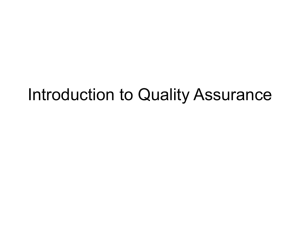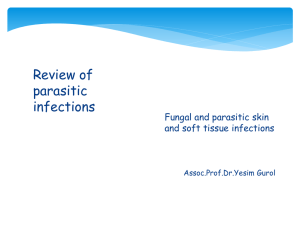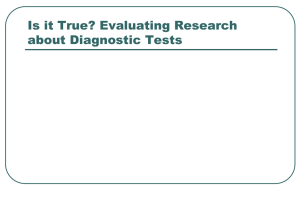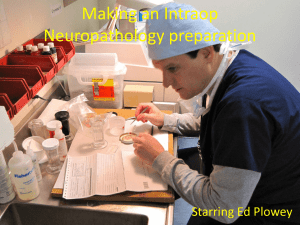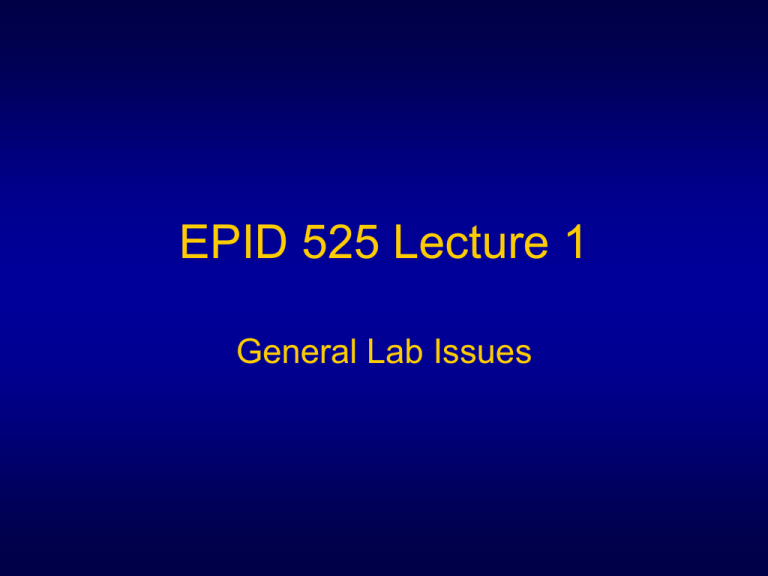
EPID 525 Lecture 1
General Lab Issues
UMHS Pathology
Anatomic
Clinical
Surgical Pathology
Autopsy
Cytopathology
Immunohistochemistry
Blood Bank
Hematology
Chemistry
Cytogenetics
Molecular
Microbiology
•
Role of the clinical microbiology
laboratory
•
Diagnostic functions
– Direct examination of the specimen
– Grow/cultivate/DETECT organisms present
– Analyze cultivated/DETECTED organisms
•
Communication of findings
– present info in such a way as to avoid or minimize
confusion
– add interpretive comments where appropriate
– provide educational updates
•
Expedited result reporting
–
•
computerized through laboratory information
systems
Review various sources of technical
guidelines
–
–
–
–
Manual of Clinical Microbiology
Clinical Microbiology Procedures Handbook
Clinical Laboratory Standards Institute
College of American Pathologists
• Specimen collection and handling
– Collection techniques
• laboratory provides instructions
• collect during acute phase, prior to
administration of antibiotics
• prepare site to minimize contamination with
normal flora
• sputum vs. saliva
http://www.pathology.med.umich.edu/handbook/
•
Specimen preservation, storage,
labeling, requisition
–
transport to the lab ASAP
•
•
•
–
oxygen anaerobes
temperature Neisseria
pH Shigella
use preservatives, or anticoagulants if
delays
• Specimen rejection
–
–
–
–
–
–
mislabeled/unlabeled
improper transport temp. or container/medium
quantity not sufficient (QNS)
leaking
delay in transport (> 2 hrs unpreserved)
inappropriately received in fixative, or received
dried up
– MUST COMMUNICATE WITH CARE TEAM
• Specimen processing
– Direct microscopic examination
•
•
•
•
can assess specimen quality (e.g. sputum)
can assess inflammation (e.g. WBCs)
compare direct smear with culture
different stains:
– Gram stain: bacteria, WBC, RBC, epithelial cells
– Fungi: KOH or calcofluor white (fluorescent)
– AFB: Kinyoun, Ziehl-Neelsen, or auraminerhodamine (fluorescent)
• Specimen processing
– Selection of culture media
• nutritive: support the growth of wide range of
(most) organisms
• differential: allow for distinguishing between
organisms because of different growth
characteristics
• selective: support the growth of one group of
organisms but not another because of the
addition of inhibitors (antibiotics, dyes, alcohol)
• Specimen processing
– Specimen preparation
• homogenization (tissue)
• concentration (CSF)
• decontamination (respiratory)
– Inoculation of solid media
• quantitative cultures
• streaking for isolation
– Nucleic acid extraction/detection
Laboratory Safety
•
Sterilization and Disinfection
–
Methods of sterilization: all forms of microbial
life (including spores) are killed
•
physical methods:
–
–
–
–
–
•
incineration: flame
moist heat: autoclave; 121ºC, 15 psi
dry heat: 160-180ºC
filtration: 0.2 μm
gamma irradiation: microwaves, X-rays
chemical method:
–
ethylene oxide: gas for heat sensitive material
•
Sterilization and Disinfection
–
Methods of disinfection: only pathogenic
microorganisms are destroyed
•
physical methods:
–
–
–
•
boiling: 100ºC, 15 min
pasteurization: 63ºC, 30 min or 72ºC, 15 sec
UV light
chemical methods:
–
–
alcohol, bleach, phenol
impacted by organism load, concentration, environmental
conditions
•
Biosafety & Exposure Control Plan
–
–
–
Employee education and orientation
Disposal of hazardous waste
Standard precautions
•
•
•
•
–
No eating, drinking, smoking, applying cosmetics
Treat every specimen as if it is HIV+
Wash hands
Avoid needlesticks, sharps exposures
Engineering controls
•
•
•
Biological safety cabinets (BSC)
Personal protective equipment (PPE)
Post-exposure control
•
Classification of Biologic Agents
–
Biosafety level 1 agents: no potential to cause
disease in healthy people
•
–
Standard precautions
Biosafety level 2 agents: most common agents
of infectious diseases
•
Standard precautions, limit access to lab, special
training and supervision, BSCs for aerosols
•
Classification of Biologic Agents
–
Biosafety level 3 agents: unusual pathogens not
routinely encountered.
•
•
–
Biosafety level 4 agents: rarely encountered
hemorrhagic fever viruses and arboviruses
•
•
Mycobacterium tuberculosis, mould forms of dimorphic
fungi, Francisella, Brucella TRANSMITTED BY
AEROSOL
BSL 2, plus engineering controls, additional PPE
BSL 3, plus special containment and PPE
Mailing Biohazardous Materials
•
Regulated by the International Air Transport
Association (IATA)
–
Dangerous goods regulations
CLIA
• Clinical Laboratory Improvement Act of 1988
• Resulted from public and Congressional concerns
about the quality of clinical laboratory testing in the
U.S.
• Basic set of guidelines to apply to all labs,
regardless of size, complexity, or location.
• Implementation and development of working
guideline was assigned to HCFA (Health Care
Finance Agency), now known as CMS (Center for
Medicare and Medicaid Services).
Labs exempted from CLIA 88
•
•
•
•
•
Labs accredited by state agencies (NY, WA)
Law enforcement agencies
Forensic testing and SAMSHA accredited labs
Patient self-testing
Research testing of human samples when
there is no report of patient specific results.
• VA system
CLIA
• The intent of CLIA is to promote the
development, implementation, delivery,
monitoring, and improvement of high
quality laboratory services.
CLIA
Original consisted of 4 sets of rules describing:
Laboratory standards
Personnel standards
Quality control requirements
Test complexity model
Quality assessment of the complete testing process
Application process and user fees
Enforcement procedures
Approval of accreditation programs
Total Testing Process
Pre Analytic
Analytic
Post-Analytic
Physician order
Patient preparation
Specimen acquisition
Specimen handling
Sample transport
Sample prep
Analyzer setup
Test calibration
Quality Control
Sample analysis
Test report
Transmittal of report
Receipt of report
Review of test results
Action on test results
Quality Assurance
Program designed to monitor and evaluate
the ongoing and overall quality of the total
testing process
(preanalytic, analytic, and postanalytic)
Quality Control
Activities designed to monitor and evaluate
the performance of instruments and reagents
used in the testing process
Is a component of a QA program
Quality Assurance activities
Patient test management assessment
- specimen collection, labeling, transport
- test requisition
- specimen rejection
- test report format and reporting systems
Quality control assessment
- calibrations and controls
- patient data ranges
- reporting errors
Quality Assurance activities (cont.)
Proficiency testing assessment
- regulated and unregulated analytes
Comparison of test results
- different assays or instruments used
for same test
- accuracy and reproducibility
Quality Assurance activities (cont.)
Relationship of patient info. to test results
- results consistent with patient info.
- age, sex, diagnosis, other results
Personnel assessment
- education; competency
Quality Assurance activities (cont.)
Communications and complaint investigations
- communications log
QA review with staff
- review during regular meetings
Quality Assurance activities (cont.)
QA records
- retention for 2 years
Verification of methods
- accuracy, precision
- analytical sensitivity and specificity
- reportable range
- reference range(s) (normal values)
Quality Assurance activities (cont.)
Quality monitors
- TAT
- smear/culture correlation
- contamination rates
Assessment of compliance
College of American Pathologists (CAP)
- Profession pathology organization
- Been granted “deemed status” by CMS
- Groups of peers conduct bi-annual site
inspections
- Publish checklists for laboratories to
document compliance
The next driver of changes?
• Maryland General Hospital in Baltimore
– Over a period of 14 months, the lab
reported almost 500 HIV and hepatitis
serologies when quality control was out.
– Lab and hospital passed CAP and JCAHO
inspections during this time period.
• Result “Unannounced” inspections
How do we assess the
performance of our tests?
Verification
•
Background
•
CLIA requirement to check (verify) the
manufacturer’s performance specifications
provided in package insert
–
–
Assures that the test is performing as intended by
the manufacturer
» Your testing personnel
» Your patient population
» Your laboratory setting
One time process performed prior to
implementation
Verification
•
Accuracy
•
Are your test results correct?
–
Assures that the test is performing as intended by
the manufacturer
» Use QC materials, PT materials, or previously
tested patient specimens
Verification
• Precision
•
Can you obtain the same test result time after
time?
–
–
Same samples on same/different days
(reproducible)
Tested by different lab personnel (operator
variance)
Verification
• Reportable Range
•
How high and how low can test values be and
still be accurate (qualitative)?
–
•
Choose samples with known values at high and
low end of range claimed by manufacturer
What is the range where the test is linear
(quantitative)?
–
Test samples across the range
Verification
• Reference ranges/intervals (normal
values)
•
Do the reference ranges provided by the test
system’s manufacturer fit your patient
population?
–
–
Start with manufacturer’s suggested ranges
Use published ranges
» Can vary based on type of patient
» May need to adjust over time
» Normal patients should be within range,
abnormal patients should be outside range
Verification
• Number of samples to test
•
Depends on the test system and laboratory
testing volume
–
–
•
•
FDA-approved: 20 positive and negatives
Non-FDA approved: 50 positive and negatives
The number used for each part of the
verification will vary
Laboratory director must review and approve
results before reporting patient results
Sensitivity
• The probability of a positive test result given
the presence of disease
• How good is the test at detecting infection in
those who have the disease?
• A sensitive test will rarely miss people who
have the disease (few false negatives).
Specificity
• The probability of a negative test result
given the absence of disease.
• How good is the test at calling
uninfected people negative?
• A specific test will rarely misclassify
people without the disease as infected
(few false positives).
Sensitivity and Specificity
DISEASE
Present
Absent
True
False
Positive Positive Positive
(TP)
(FP)
TEST
False
True
Negative Negative Negative
(FN)
(TN)
Sensitivity = TP/TP+FN
Specificity = TN/TN+FP
Predictive Value
• The probability of the presence or
absence of disease given the results of
a test
– PVP is the probability of disease in a
patient with a positive test result.
– PVN is the probability of not having
disease when the test result is negative.
Predictive Value
DISEASE
Present
Absent
True
False
Positive Positive Positive
(TP)
(FP)
TEST
False
True
Negative Negative Negative
(FN)
(TN)
Predictive Value Positive (PVP) = TP/TP+FP
Predictive Value Negative (PVN) =TN/TN+FN
Predictive Value
• How predictive is this test result for this
particular patient?
• Determined by the sensitivity and
specificity of the test, and the
prevalence rate of disease in the
population being tested.
Prevalence Rate
Number of cases of illness existing
at a given time divided by the
population at risk
Anatomy of an epidemic:
W eeks fro m Peak
14
12
10
8
6
4
2
0
-2
-4
-6
-8
18
16
14
12
10
8
6
4
2
0
-10
P ercen t of Cases
first case - transition - peak - last case
Hypothetical Influenza Test Performance
Prevalence = 20.0%
Disease
+
-
+
380
64
-
20
1536
Test
Sensitivity = 380/400 = 95.0%
Specificity = 1536/1600 = 96.0%
Predictive Value Positive (PVP) = 380/444 = 85.6%
Predictive Value Negative (PVN) = 1536/1556 = 98.7%
Hypothetical Influenza Test Performance
Prevalence = 1.0%
Disease
Test
+
-
+
19
80
-
1
1900
Sensitivity = 19/20 = 95.0%
Specificity = 1900/1980 = 96.0%
Predictive Value Positive (PVP) = 19/99 = 19.2%
Predictive Value Negative (PVN) = 1900/1901 = 99.9%
100%
80%
60%
40%
20%
0%
2%
4%
6%
8%
10
%
12
%
14
%
16
%
18
%
0%
20
%
Predictive Value Positive
Predictive Value Positive
Dependence on Sensitivity, Specificity and
Prevalence
Prevalence
Sens/Spec:
80/80
90/90
95/95
99/99
Predictive Values of Hypothetical Test Based
on Wisconsin & National Prevalence
Surrogates, 1999/2000 & 2000/2001
110.0%
100.0%
90.0%
80.0%
70.0%
60.0%
50.0%
40.0%
30.0%
PVN
PVP
State
(Wisconsin)
Data
20.0%
10.0%
0.0%
110.0%
100.0%
90.0%
80.0%
70.0%
60.0%
50.0%
National
(CDC) Data
40.0%
30.0%
20.0%
10.0%
0.0%
• The PVP varies widely throughout the year.
• The PVN displays much less variability through the year
Infection Control
•
Incidence of Nosocomial Infections
–
Function of IC is to prevent hospitalacquired (nosocomial) infections
•
•
–
Historically, handwashing was found to
prevent nosocomial infections
These infections add days to patient stays
and increase morbidity and mortality
Tracked by National Nosocomial
Infections Surveillance (NNIS) by the
CDC
•
Types of Nosocomial Infections
–
–
–
–
•
Urinary tract infections: indwelling catheters
Lung infections: intubation or ventilator
Surgical site infections
Bloodstream infections: indwelling devices
Emergence of Antibiotic-Resistant Organisms
–
–
–
–
–
–
MRSA: Methicillin resistant Staphylococcus aureus
VRE: Vancomycin resistant Enterococcus
VISA: Vancomycin intermediate Staphylococcus aureus
VRSA: Vancomycin resistant Staphylococcus aureus
ESBL: Extended spectrum beta lactamase producing
enteric gram negative bacilli
Toxigenic Clostridium difficile
•
Hospital Infection Control Programs
–
Establish programs to prevent the spread of
microorganisms
Standard precautions for all patients
Transmission-based precautions for selected patients
–
–
•
•
TABLE 5-1
Role of the Microbiology Laboratory
–
–
Provide data to IC regarding positive cultures
Work with IC to report infections of public health
importance
Characterizing Strains Involved in an Outbreak
–
•
•
•
Antibiograms
Serotyping
Molecular typing

